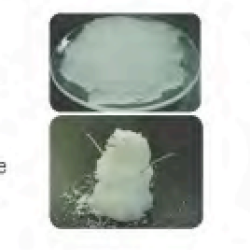Source Institutions
Source Institutions
Add to list Go to activity
Activity link broken? See if it's at the internet archive

In this activity on page 4 of the PDF (Behind the Scenes with Chemistry), learners make some special effects, including snow and breaking glass, with supplies found in the home. In the first activity, learners make and observe four different types of fake snow using different amounts of water and a polymer called sodium polyacrylate. In the second activity, learners make breakable glass using sugar, a hygroscopic material that absorbs water from its surroundings.
Safety notes: Adult supervision required. The sodium polyacrylate powder is irritating to the eye and nasal membranes. If you cut open diapers to remove the sodium polyacrylate, avoid shaking the diapers a lot, since doing so is more likely to irritate your nose. Always wear goggles when doing this activity. Do not put sodium polyacrylate in the sink, as it may clog the drain! Wash your hands thoroughly after this activity and follow the other safety tips on page 3 of the PDF.
Safety notes: Adult supervision required. The sodium polyacrylate powder is irritating to the eye and nasal membranes. If you cut open diapers to remove the sodium polyacrylate, avoid shaking the diapers a lot, since doing so is more likely to irritate your nose. Always wear goggles when doing this activity. Do not put sodium polyacrylate in the sink, as it may clog the drain! Wash your hands thoroughly after this activity and follow the other safety tips on page 3 of the PDF.
- Under 5 minutes
- 1 to 2 hours
- $10 - $20 per student
- Ages 8 - 14
- Activity, Experiment/Lab Activity
- English, Spanish
Quick Guide
Materials List (per student)
- 1.25 teaspoons sodium polyacrylate, can be purchased online or in baby diapers
- ~8 tablespoons distilled water
- Magnifying glass
- 5 small clear plastic plates
- 3 wooden stir sticks
- 3 plastic cups (5 ounce)
- Measuring spoons (1/4 teaspoon, 1 tablespoon)
- 2 tablespoons of water
- 1/2 cup of light corn syrup
- 1/4 teaspoon cream of tartar
- 1 3/4 cups granulated sugar
- Candy thermometer
- Deep sauce pan (1 qt)
- Cooking spoon
- Non-stick cooking spray
- 9 in x 12 in cookie sheet with edges
- Spatula
Subjects
-
Physical Sciences
-
Heat and Thermodynamics
- Heat and Temperature
-
Chemistry
- Chemical Bonding
- Chemical Reactions
- Solutions
-
States of Matter
- Solids
- Liquids
- Changes of Phase
-
Structure and Properties of Matter
- Atomic Structure
-
Heat and Thermodynamics
-
The Nature of Science
-
The Scientific Process
- Conducting Investigations
- Gathering Data
- Formulating Explanations
- Communicating Results
-
The Scientific Process
Informal Categories
- Food and Cooking
- Performing Arts
- Photography and Film/Video
Audience
To use this activity, learners need to:
- see
- see color
- read
- touch
Learning styles supported:
- Links STEM to other topics of interest such as arts and humanities
- Involves hands-on or lab activities
Other
Foreign language versions of this resource:
Access Rights:
- Free access
By:
- Jaworek-Lopes, Christine
Rights:
- All rights reserved, American Chemical Society, 2010
